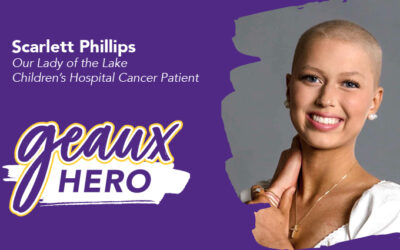As a drummer, Lafayette native Steve Dugas traveled across the South with acts like Sonny Landreth, Bobby Kimball, Julius Farmer and Willie Tee. Now 72, Dugas’ touring days are behind him, but he keeps a drum kit at home and plays for his own enjoyment.
When he wasn’t behind the drum kit, Dugas often worked as a contractor, among other jobs he held throughout his career. He’s always been active, so he never imagined his health would take drastic, life-threatening turns in recent months.
The problems began when Dugas, upon medical advice, discontinued his blood thinner in preparation for a routine procedure. On the day the procedure was scheduled to occur, Dugas woke up with severe arm pain. Doctors diagnosed him with blood clots, treated him and sent him home the next afternoon. Dugas thought he’d recovered, so he resumed some normal activities. But, a visit to a convenience store across the road from his home an hour after returning home was anything but normal.
“I took three steps and all of a sudden it felt like somebody had tripped me,” Dugas recalled. “I didn’t realize it at the time, but I was also sweating profusely. I just knew that I had fell.”
A bystander immediately noticed Dugas was having stroke-like symptoms. She and others jumped into action, providing aid and calling an ambulance. One woman recognized Dugas and realized she had gone to school with his son. She searched online and found contact information for Dugas’ son, who was able to contact his daughter-in-law Dani Guernsey. She soon arrived and accompanied the ambulance and Dugas to Our Lady of Lourdes Regional Medical Center.
“I’m not sure if Mr. Steve understands how bad his situation was when we first arrived in the ER,” Guernsey said. “He had lost the use of the right side of his body. His eyes weren’t functioning correctly, so he was always looking to the left. His speech was really slurred. If he hadn’t gotten to the hospital in such a quick fashion and been treated with a top level of care, it would have changed his life completely.”
The dedicated team at the Our Lady of Lourdes Stroke Center of Excellence, the only facility of its kind in Acadiana, confirmed Dugas’ diagnosis and immediately provided treatment for a blood clot in his brain. Time is critical when treating someone who has suffered a stroke, so the hospital’s stroke team is on call 24 hours a day, seven days a week.
There are two main types of stroke – one caused by blood clots and one caused by bleeding – that require completely different types of treatment, noted Dr. Saad Karim, a vascular neurologist and one of the stroke team leads for Our Lady of Lourdes Health.
“When the ambulance is en route, they tell us that they suspect a stroke. That creates a hospital-wide FAST Alert that there is a potential stroke patient coming to the ER,” Dr. Karim explained. “Once they arrive, we do a quick assessment where we look at the patient’s blood pressure and do a CT scan of the head to look for bleeding. If that’s negative, we do immediate blood vessel imaging to look for clots.”
Test results help providers determine the proper course for treatment, Dr. Karim said, which could involve surgery to stop any internal bleeding or a less-invasive procedure to remove any blood clots.
“The patient is then placed in the ICU and treated by a critical care nursing team because we have to take a lot of precautions after such an event,” Dr. Karim said. “The stroke neurologist will conduct an MRI and the physicians discuss why the stroke happened. It’s a very comprehensive process.”
That process earned national recognition, including the Gold Seal of Approval from The Joint Commission for Primary Stroke Centers and the American Heart Association Get With The Guidelines Gold Plus Award. For Dugas, it meant the team spent time removing a blood clot and conducting follow-up imaging to ensure there were no other issues. Just a few weeks after his stroke, Dugas is on his way to a full recovery.
“I’m walking around and talking and have all of my senses,” Dugas said. “I’m still a little unsteady and have to be very cautious. I have to pay a lot more attention during activities than before. But, I’m grateful because I know it could have been so much worse.”
Dugas’ positive outcome happened largely because he received treatment so quickly, Dr. Karim noted. In general, stroke patients who are treated within four and a half hours after the incident tend to recover better than those who do not receive care in a timely fashion.
Experts advise people to use the acronym B-E-F-A-S-T to watch out for possible stroke symptoms:
- Balance: Is the person having loss of coordination, trouble walking or dizziness?
- Eyesight: Does the person have double vision or trouble seeing?
- Face: Ask the person to smile. Does the face look uneven?
- Arm: Ask the person to raise both arms. Does one arm drift down?
- Speech: Does the person’s speech sound strange?
- Time: If you observe any of these signs, call 911 immediately.
“It’s common to hear from patients who say they woke up with weakness in the arm and thought it was because they slept wrong,” which Dr. Karim said often leads patients to delay seeking immediate medical attention. “When it doesn’t improve after several hours, they realize it’s something else. We always tell people to come as soon as you have those symptoms.”
Immediate intervention and treatment is just the beginning of the stroke care journey, Dr. Karim explained. Most people participate in some type of rehab, and Dr. Karim or another member of the team works with patients to manage risk factors to prevent another stroke. Managing risk factors requires lifestyle modifications like eating a healthy, low-fat diet, eating more salads, lean meats and foods with omega-3 fatty acids, exercising for 30 minutes at least four to five times a week, quitting smoking, and managing conditions like high blood pressure and high cholesterol with medications.
“What I’ve seen in terms of the care at Lourdes is a wonderful team approach,” Guernsey said. “For us, it started out as a really intense time of unknown and concern and worry to an outcome that feels miraculous. I think it’s because everything was so organized and thorough. Everything was smoothly orchestrated from the time the call came in to Lourdes until today.”




